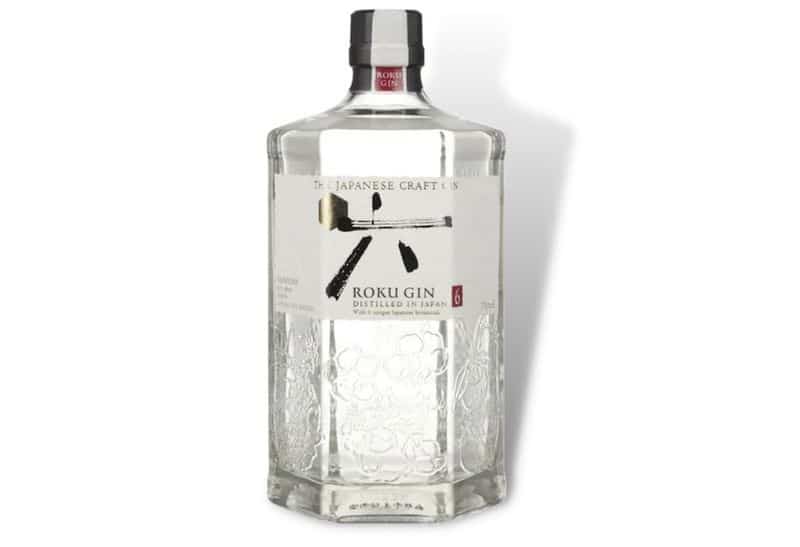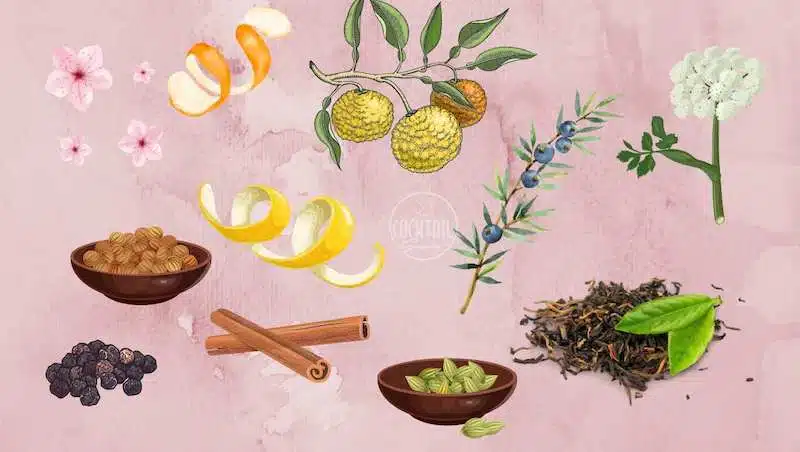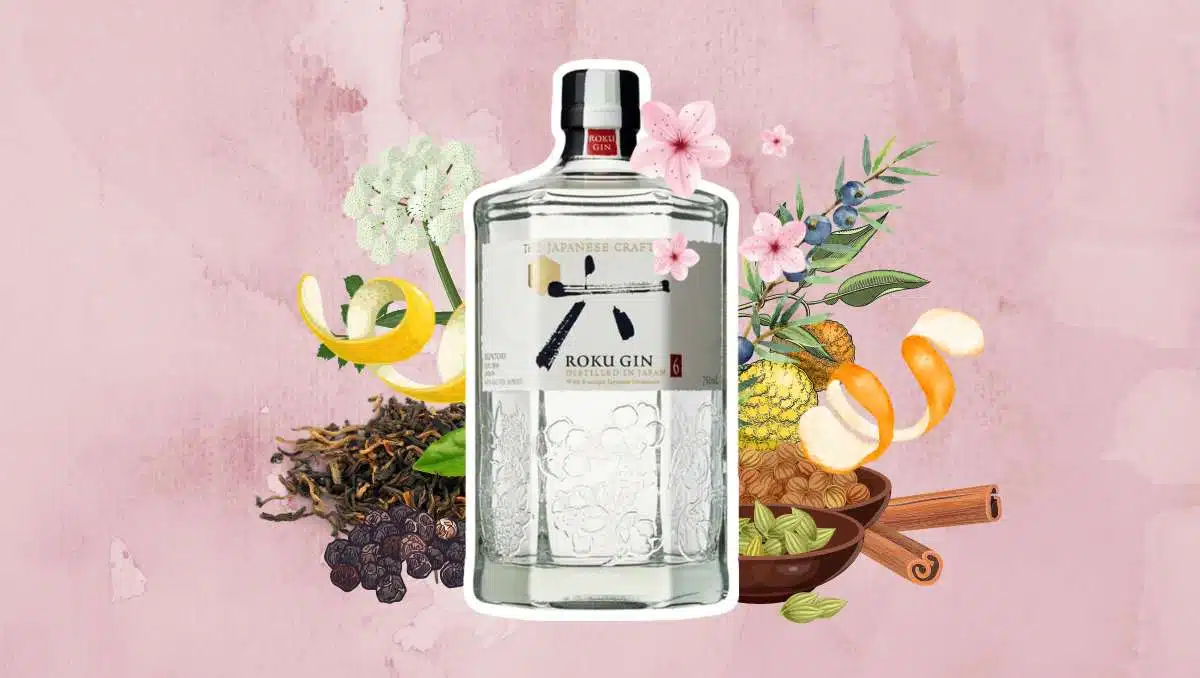Roku Gin is an excellent craft gin produced by the world-renowned Whisky producer Suntory. The term "Roku" is Japanese for six. That hints to the face that the list of botanicals includes six typical Japanese ingredients.
Further, these six botanicals reflect the four seasons in Japan: the Sakura flower as a symbol of spring, Green tea like Sencha and Gyokuro for summer, Sansho pepper for winter, and last but not least, yuzu as a symbol of Japanese winters.
The subtle taste and flavor profile makes it seem like Roku is a gin you can easily incorporate into a Gin & Tonic or other mixed drinks. However, Roku Gin is quite challenging due to the complex herbal notes coming from the tea.
Roku Gin Review Summary
- Produced By: Suntory
- Owned By: Beam Suntory
- Product Website: Product Website
- Production Location: Osaka, Japan
- Classification: New Western Dry Gin
- Known botanicals: Sakura flowers, yuzu, Sencha tea, Gyokuro tea, sansho pepper, juniper, coriander, angelica, and more (see below)
- Base Spirit: Neutral grain spirit
- Aging: No Age Statement (NAS)
- ABV: 43% ABV (47% ABV in Japan)
- Proof: 86 (94 in Japan)
- Price: $26 / 750 ml
- Overall Rating: 4/5
Tasting notes
Roku Gin has a delicate nose with a floral aroma and top notes of cherry blossom. You can also smell green tea, yuzu, lemon, and hints of pepper. The beauty of Roku Gin is that it shows a great variety of aromas. Each is somewhat subtle and not overpowering but at the same time clean and sharp.
On the palate, Roku Gin is smooth and oily with a rich mouthfeel. Once the gin coats your tongue, you can taste quite strong notes of juniper with hints of cherry blossom.
The citrus notes are a bit less dominant compared to the aroma. In contrast, the bitter notes of green tea are far more pronounced. This unexpected touch of bitterness is also the main reason why this gin is challenging to mix.
On Ice
When served chilled or on ice, the subtle cherry blossom flavors vanish, and in return, the bitter tea notes are even more intense. In combination with juniper, the flavor profile shifts slightly from subtly floral to delicately piney and bitter.
Cocktails
Gin and Tonic
Roku Gin works great in a classic G&T. Combined with a classic Indian tonic water (Fever-Tree or Thomas Henry), it offers a unique taste with well-balanced flavors. However, my favorite pairing is with Goldberg Yuzu tonic.
The gin might be slightly more bitter than other options, whereas Goldberg Yuzu is less bitter than most tonics. Both ingredients contain subtle yuzu flavors and are a match made in heaven.
Negroni
I don't like Roku as much in an equal parts Negroni as in a Gin and Tonic. The pronounced bitter notes in the gin lead to a rather unbalanced Negroni cocktail. Even after tweaking the recipe, I couldn't find a balance that convinced me.
However, in our Coconut Negroni recipe, Roku Gin works exceptionally well. The addition of coconut rum balances the bitter notes of Roku and highlights the sakura notes that harmonize very well with sweet coconut.
Gin Fizz
I found the bitter tea notes a bit distracting in a classic Gin Fizz. Luckily, I read this before in other reviews, so I wasn't too surprised and prepared some fruity and floral syrups to fix that.
The best version I came up with was a Roku Gin Fizz made with floral (elderflower) syrup. The elderflower syrup masked the bitter tea flavors and turned the cocktail into a spectacular floral summer cocktail.
Roku Gin Bottle Design
If you remember, Roku means six. This number reflects the six Japanese botanicals in the list of ingredients. On the bottle label, you can also see a small "6" inside a red square next to the name Roku Gin.

The choice of colors, red for the square on a white background looks familiar? That's because they're the same as seen on the Japanese flag.
When touching the label, you can feel it is not made of ordinary paper. Indeed, quick research reveals that it's washi paper, another highlight of Japanese craftsmanship.
The bottle shape also looks a bit unusual at first. On closer inspection, you see that the corners build a hexagon. -One more hidden clue to the six Japanese ingredients.
You can find all six natural Japanese botanicals embossed on the glass of the bottle.
Botanicals in Roku Gin

Roku Gin is flavored with a total of 14 botanicals. Six of them are natural ingredients Japan is famous for. The other eight botanicals are more common and are in many gins. So, here's the complete list of botanicals:
- Sakura flowers (cherry blossoms)
- Sakura leaves
- Yuzu peel
- Sencha tea
- Gyokuro tea
- Sansho pepper
- Juniper
- Coriander
- Angelica root
- Angelica seeds
- Cardamom
- Cinnamon
- Lemon peel
- Bitter orange peel
About the Brand
Roku Gin is a brand that belongs to Japanese Whisky producer Suntory. However, Suntory also boasts a long history of producing excellent gin and produces gin since 1936 when they launched their first gin brand (Hermes Gin).
In 2017, Suntory launched Roku Gin and took advantage of the wave of increasingly popular New Western Dry Gins. These gins feature weaker juniper notes and new, often regional botanicals. For Roku Gin, they made use of this trend and mixed classic Japanese botanicals like sakura flowers, yuzu, and tea with proven botanicals like angelica, coriander seeds, cardamom, and more.
What Type of Gin is Roku?
Roku Gin is a modern gin, often referred to as contemporary gin or New Western Dry Gin. The base is made from grains infused with a total of 14 botanicals.
Roku is great for sipping neat. However, it's quite a challenging gin for mixing. The unusual flavor profile with bitter notes and the subtle sweetness often don't work in cocktails as one might expect.
The Roku Gin Travel Retail Select Edition
Roku Gin is available in two variations. One is the standard bottle, and then there's the Travel Retail Select Edition.
It looks nearly the same and has a similar flavor profile as the regular version. But compared to the standard bottle, the taste of Sakura flowers is more pronounced.
In Japan, the standard flagship bottle is also slightly larger and higher in alcohol, clocking in at 47% ABV instead of the international 43% ABV.
Pros & Cons
Pros
- Unique flavor profile
- Exotic, Japanese botanicals
- Great value for money
Cons
- Bitter tea notes can be distracting in many classic gin cocktails
Conclusion
Overall, Roku Gin is an exceptional gin with unusual ingredients and flavors. This results in a bold and complex flavor profile. It may be hard to find the right tonic for this gin, but in combination with a Goldberg Yuzu tonic, it works great.
Roku Gin can also be tricky to use in cocktails, but with time and practice you'll learn how to use this gin appropriately. Starting points should be a classic Negroni or a Gin-Gin Mule.

